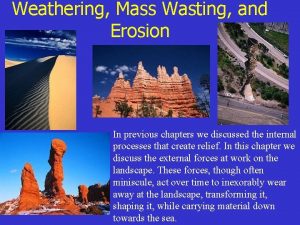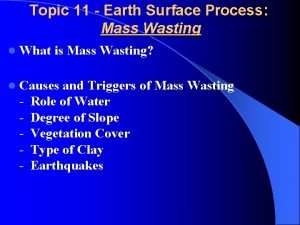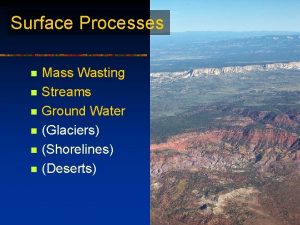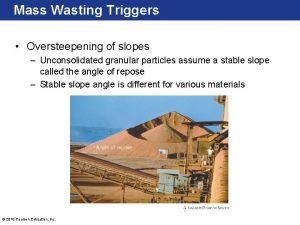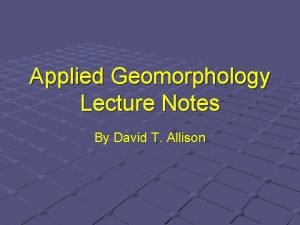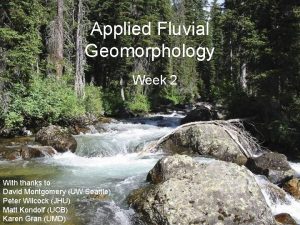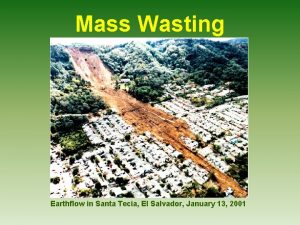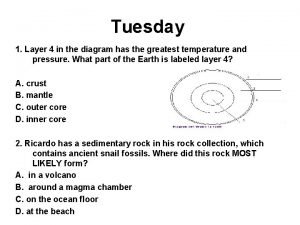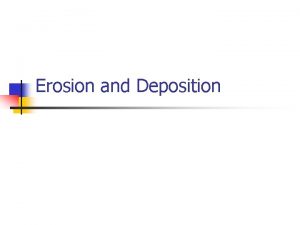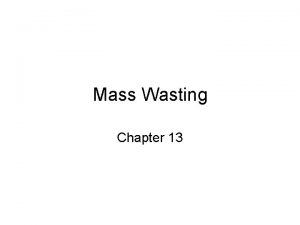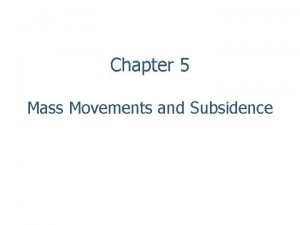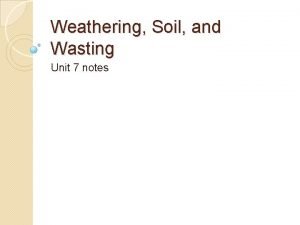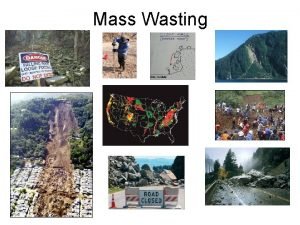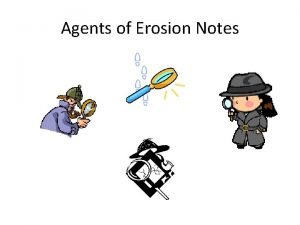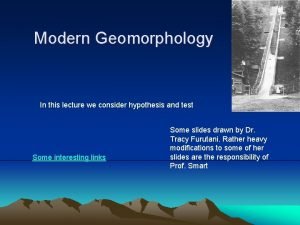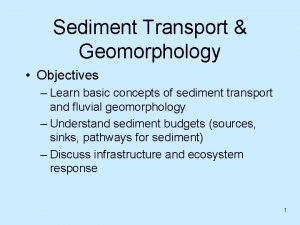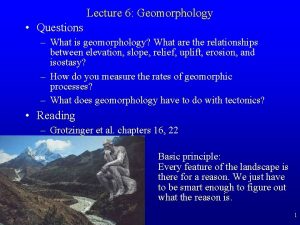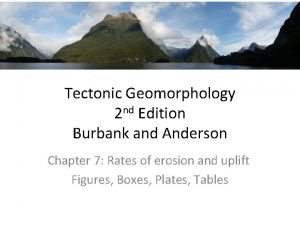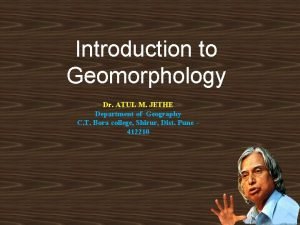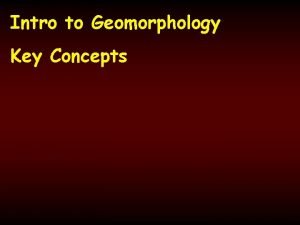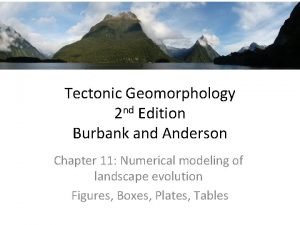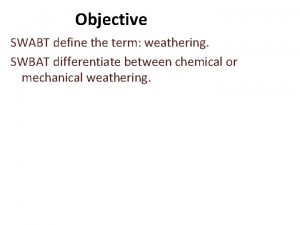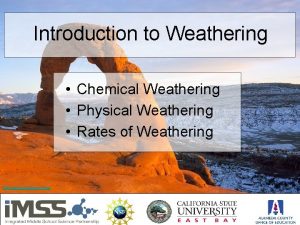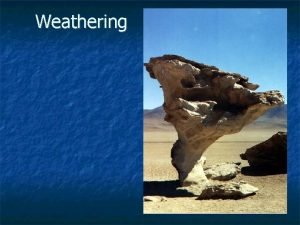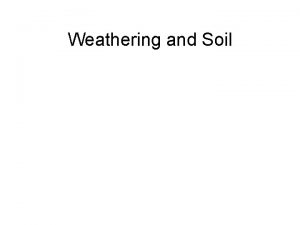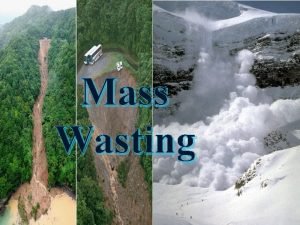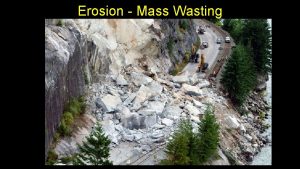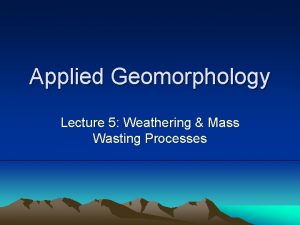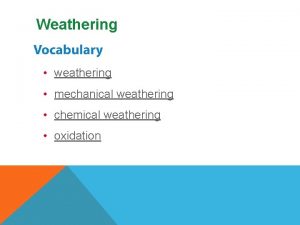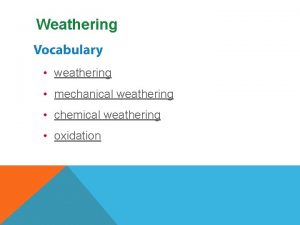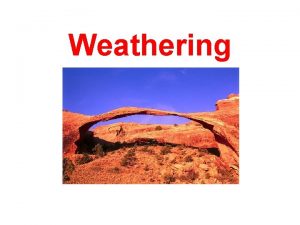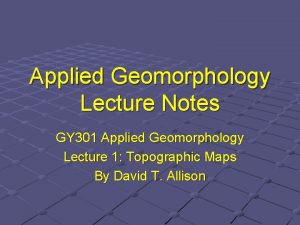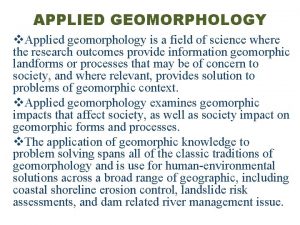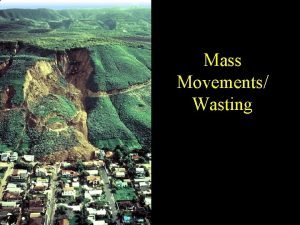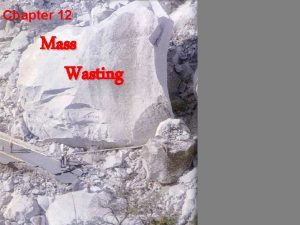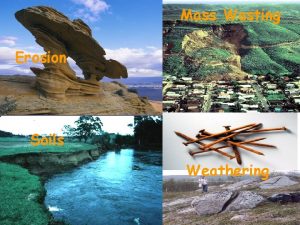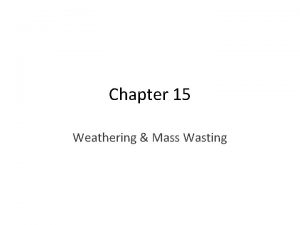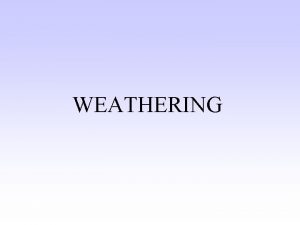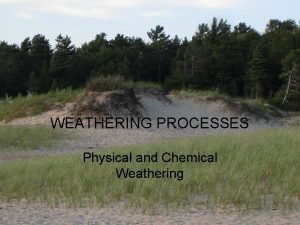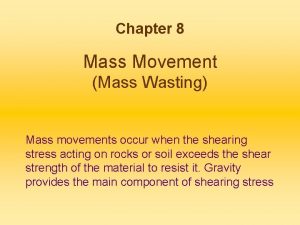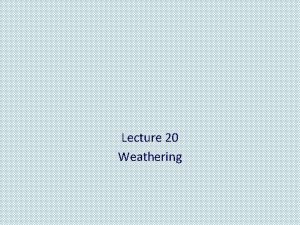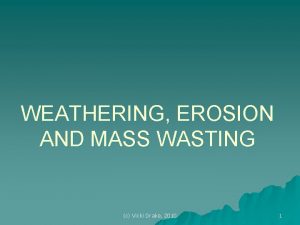Applied Geomorphology Lecture 5 Weathering Mass Wasting Processes

























- Slides: 25

Applied Geomorphology Lecture 5: Weathering & Mass Wasting Processes

Weathering • Chemical Weathering – Hydration: chemical reaction that consumes H 2 O [ 2 KAl. Si 3 O 8 + 2 H 2 CO 3 + H 2 O = Al 2 Si 2 O 5(OH)4 + 4 Si. O 2 + 2 K+ +2 HCO 3 - ] – Oxidation: chemical reaction that consumes oxygen [ Fe 2 Si. O 4 + ½O 2 = Fe 2 O 3 + Si. O 2 ] – Dissolution: dissolving of minerals into solution [ Na. Cl + H 2 O = Na+ + OH- + H+ + Cl- ] • Physical Weathering – – – – Ice wedging Thermal stress Spheroidal weathering Biologic activity Soil creep Solifluction Exfoliation

Chemical Stability of Rock Forming Minerals • Silicates correlate with Bowen’s Reaction Series

Weathering examples • Fe-oxide formation from oxidation

Weathering Examples cont. • Joint patterns allowing physical and chemical weathering

Weathering Examples cont. • Biologic activity

Weathering Examples cont. • Frost wedging

Weathering Examples cont. • Exfoliation dome formation (Stone Mt. GA)

Weathering Factors • Climate – Rainfall – Average temperature – In some climates chemical weathering dominates, in others physical weathering dominates • Bedrock type (mineralogy) – Bowen’s Reaction series • Topography (Soil formation) – Steep: little or no soil – Flat: abundant soil • Duration of weathering process

Soil Profile • A horizon: >50% organic humus mixed with sand, silt and clay • B horizon: sand size particles surrounded by a matrix of soluble residue and clay minerals • C horizon: bedrock is weathered but still recognized

Soil Profile Schematic • A, B and C horizons • Porosity: % void space in material • Permeability: ability to transmit a fluid

Soil Types • Pedalfer: originate in temperate humid climate zones. Well developed A, B and C horizons. • Pedocal: originate in arid and semi-arid temperate climates. Contain abundant Ca. CO 3 in B horizon; All horizons are poorly developed. • Laterites: originate in humid tropical climates. Contain mainly Al 2 O 3. Horizons are poorly developed.

Mass Wasting • Movement of material down-slope as the result of gravity • Classified based on 2 parameters: – Type of material • Rock • Debris, earth • Mud – Velocity of motion • Fall, avalanche • Slide • Flow

Mass Wasting

Rock Slide Example • Gross Ventre (near Jackson Hole, Wyoming) (photograph courtesy of A. G. I)

Gross Ventre Topographic Map

Slump Example • Upper portion of slump is a slide producing a noticeable “scar” • Lower portion is generally an earthflow (photograph courtesy of A. G. I)

Slump Example • Slumps commonly affect man-made structures and are often triggered by poor construction practices

Mudflow Examples • Lahar: driven by volcanic eruptions (Photo courtesy of USGS)

Soil Creep • Slow movement of soil downslope due to frost heave or cyclic wetting/drying.

Solifluction • Slow earthflow movement downslope in permafrost regions

Debris Flow • Moderately fast movement of unconsolidated material downslope

Rock Fall • Free-fall of rock material at high velocity

Mass Wasting “Triggers” • • • Seismic events/Construction Shocks Volcanic eruptions (Lahars) Undercutting/Slope modification Rainfall Rapid deposition (submarine turbidity flows)

Exam Review • Know chemical weathering reactions and example reaction equations. • Know the types of mechanical (physical) weathering. • Know weathering control factors. • Know the relationship between Bowen’s reaction series and the susceptibility to weathering. • Be familiar with the circumstances that lead to lahar, solifluction, soil creep, rock slides, and slumps. • Be familiar with soil horizons and soil types.
 Mass wasting
Mass wasting Crescent-shaped cliffs at the head of a slump
Crescent-shaped cliffs at the head of a slump Mass wasting processes
Mass wasting processes Fast movement
Fast movement Applied geomorphology notes
Applied geomorphology notes Applied fluvial geomorphology
Applied fluvial geomorphology Santa tecia
Santa tecia Mass wasting
Mass wasting Mass wasting
Mass wasting Mass wasting
Mass wasting Subsidence mass wasting
Subsidence mass wasting Mass wasting
Mass wasting Mass wasting definition
Mass wasting definition Mass wasting occurs when____.
Mass wasting occurs when____. Geomorphology hypothesis
Geomorphology hypothesis Objectives of geomorphology
Objectives of geomorphology Forces
Forces Geomorphology
Geomorphology Application of geomorphology
Application of geomorphology Dynamic equilibrium in geomorphology
Dynamic equilibrium in geomorphology Geomorphology
Geomorphology Agents of physical weathering
Agents of physical weathering Example of chemical weathering
Example of chemical weathering Types of weathering
Types of weathering What are the main types of chemical weathering
What are the main types of chemical weathering Concurrent processes are processes that
Concurrent processes are processes that
